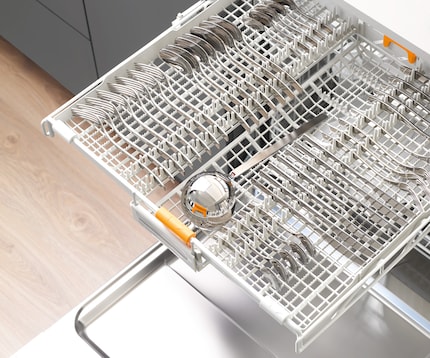
Background information
That's why good table knives are in danger in the dishwasher
by Martin Jungfer

Even if your cutlery is «dishwasher safe», putting it in the dishwasher is a risky business. Especially for knives. But if you’re still too lazy to wash them by hand, here are a few survival tips.
Good kitchen knives don’t belong in the dishwasher. That much is clear. But what about regular knives? Can they go in the dishwasher? After all, most cutlery sets are touted as «dishwasher safe» or «dishwasher proof». The industry, you see, knows that we customers are predisposed towards convenience.
I recently discovered that not all knives are made equal. However, manufacturers do keep the dishwasher in mind when making knives.
You’d be hard pushed to find a cutlery set on the market that wouldn’t survive a dishwasher cycle. I want to find out the exact meaning of the labels which have, until now, allowed me to bung forks, spoons and knives alike into the dishwasher without giving it a second thought. Time to ask Joachim Hauser, an engineer at the RAL German Institute for Quality Assurance and Certification e.V. This almost century-old institution is the custodian of the RAL colour standard and awards all sorts of quality marks. It even gives them out to gabions and farm holidays.
Unlike these quality marks, RAL registrations such as «dishwasher safe» are made on a purely voluntary basis in certain sectors. There are no independent checks or monitoring. Thus, they don’t cut it as an official quality seal.
When it comes to cutlery, one company may outsource production to another, using the RAL-RG number to agree on a standard of quality and workmanship. Hauser calls them «quality-enhancing, technical testing standards or other classification regulations for products and services».
For a cutlery set to be «dishwasher safe», twelve of its pieces need to meet the RAL-RG 604 quality requirements in an endurance test spanning over 1,000 wash cycles. At the end of the test, at least ten of these knives, forks and spoons need to be free of rust spots over 0.4 millimetres in size. Cracks are a no-no as well. The vast majority of mass-market cutlery achieves this standard, as most knives are made of that tried-and-tested alloy, 18/10 stainless steel. Unfortunately, the «dishwasher safe» label tells us nothing about whether these knives will stay sharp for a long time or be spared of rainbow-like stains.
Other pieces of cutlery are often made of chrome-nickel steel. The nickel contained in this alloy makes spoons and forks even more robust against knocks.
Pricier cutlery sets containing hollow handle knives, whereby the handle and blade are made from different materials, are also almost always sold as «dishwasher safe».
So, can you bung everything into the dishwasher without a second thought? It’s complicated. Monobloc stainless steel specimens in particular have little to fear from dishwasher cleaning. They’re not made to last forever anyway; their blades go blunt eventually and can barely be resharpened.
Knives with hollow handles have blades made of special steel, making them able to cut especially well. Neither time nor use darkens these blades, unlike with their monobloc counterparts. It’s more expensive knives you can typically enjoy for longer. All the more reason to wash them by hand, where they’re only exposed to high temperatures for a short time. In the dishwasher, on the other hand, one cycle takes up to two or three hours, during which the knives are permanently exposed to hot steam. That doesn’t do them any favours.
If you still don’t want to wash them by hand, here are some things that can steer you right:

Here are some tips if you’re in the process of investing in new cutlery:
How do you wash your knives?
The competition has ended.
Journalist since 1997. Stopovers in Franconia (or the Franken region), Lake Constance, Obwalden, Nidwalden and Zurich. Father since 2014. Expert in editorial organisation and motivation. Focus on sustainability, home office tools, beautiful things for the home, creative toys and sports equipment.